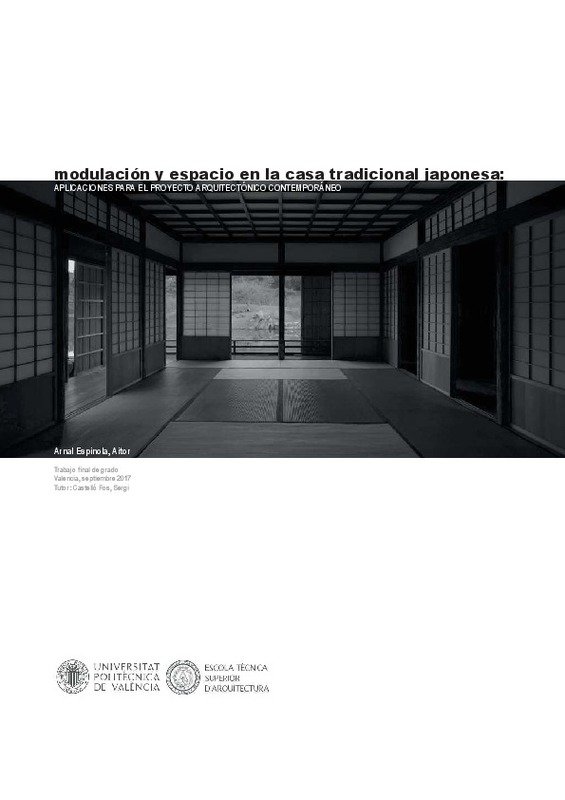JavaScript is disabled for your browser. Some features of this site may not work without it.
Buscar en RiuNet
Listar
Mi cuenta
Estadísticas
Ayuda RiuNet
Admin. UPV
Modulación y espacio en la casa tradicional japonesa: aplicaciones para el proyecto arquitectónico contemporáneo
Mostrar el registro sencillo del ítem
Ficheros en el ítem
| dc.contributor.advisor | Castelló Fos, Sergio
|
es_ES |
| dc.contributor.author | Arnal Espinola, Aitor
|
es_ES |
| dc.date.accessioned | 2018-10-16T13:23:31Z | |
| dc.date.available | 2018-10-16T13:23:31Z | |
| dc.date.created | 2017-09-14 | |
| dc.date.issued | 2018-10-16 | es_ES |
| dc.identifier.uri | http://hdl.handle.net/10251/110624 | |
| dc.description.abstract | [ES] El trabajo se orienta a la observación de las características organizativas y tipológicas de una modulación de cierta complejidad como es la de la casa tradicional japonesa. En ésta, el tatami como módulo base y las configuraciones en las que se dispone permiten ordenar tanto los tamaños de las estancias como la integración en las particiones de la estructura ligera de madera. Se propone la identificación y abstracción de las reglas de juego observadas en la casa japonesa para su aplicación a las necesidades de la vivienda contemporánea. | es_ES |
| dc.description.abstract | [EN] When talking about architecture, it is usual to think of the great masters, as well as their most representative works, which have now become not only architectural but also cultural references. However, in the present work the aim is to move away from the architect - work relationship and focus, above all, on the social, cultural and historical factors that have led to the development and evolution of the typology of traditional Japanese housing. Thus, part of the concept of housing as an entity that arises to respond to a very basic need: shelter; And that has been evolving and adapting to new needs, gaining complexity and depth from an architectural point of view. It is not therefore a simple material and impersonal object, but is linked to the people who inhabit it, to their needs, tastes and ways of dwelling. It can then be said that housing is a re! ection of the personality of the individual, which manifests itself in each of the elements that compose it. Through the presentation and study of the elements that are part of the traditional house is sought to know how they affect the design of the same, as they have evolved and changed according to new times, how they relate to each other to form complex systems, In short, to know the ìrules of the gameî that de" ne this type of architecture. In this way, from the ideas extracted, a short number of works has been selected with the intention to exemplify how the Japanese architecture has influenced the work of great architects and how the traditional systems can be applied to the contemporary project coherently and not just anecdotally. | es_ES |
| dc.format.extent | 77 | es_ES |
| dc.language | Español | es_ES |
| dc.publisher | Universitat Politècnica de València | es_ES |
| dc.rights | Reserva de todos los derechos | es_ES |
| dc.subject | Japanese architecture | es_ES |
| dc.subject | Traditional architecture | es_ES |
| dc.subject | Contemporary architecture | es_ES |
| dc.subject | Dwellings | es_ES |
| dc.subject | Houses | es_ES |
| dc.subject | Arquitectura japonesa | es_ES |
| dc.subject | Arquitectura tradicional | es_ES |
| dc.subject | Arquitectura contemporánea | es_ES |
| dc.subject | Viviendas | es_ES |
| dc.subject | Casas | es_ES |
| dc.subject.classification | PROYECTOS ARQUITECTONICOS | es_ES |
| dc.subject.other | Grado en Fundamentos de la Arquitectura-Grau en Fonaments de l'Arquitectura | es_ES |
| dc.title | Modulación y espacio en la casa tradicional japonesa: aplicaciones para el proyecto arquitectónico contemporáneo | es_ES |
| dc.type | Proyecto/Trabajo fin de carrera/grado | es_ES |
| dc.rights.accessRights | Abierto | es_ES |
| dc.description.bibliographicCitation | Arnal Espinola, A. (2017). Modulación y espacio en la casa tradicional japonesa: aplicaciones para el proyecto arquitectónico contemporáneo. http://hdl.handle.net/10251/110624 | es_ES |
| dc.description.accrualMethod | TFGM | es_ES |
| dc.relation.pasarela | TFGM\57717 | es_ES |
Este ítem aparece en la(s) siguiente(s) colección(ones)
-
ETSA - Trabajos académicos [4687]
Escuela Técnica Superior de Arquitectura






